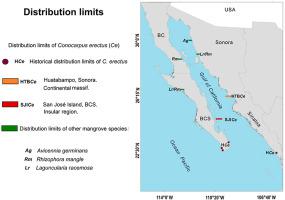Ocean & Coastal Management ( IF 4.6 ) Pub Date : 2021-04-22 , DOI: 10.1016/j.ocecoaman.2021.105645 Jonathan G. Ochoa-Gómez , Joanna Acosta-Velázquez , Carlos A. Anguamea-Valenzuela , Paulina Martinetto

|
The distribution of species can expand or retreat following environmental changes. Climate change is driving changes in the distribution of several species. Changes in mangrove distributions have been reported subsequent to an increase in temperature following a tropicalization process. This study documents the presence of Conocarpus erectus above the reported northern limit for the Gulf of California (GC), updating its distribution limit in the Neotropic. The current northern distribution limit of C. erectus in the Pacific Ocean was found at Huatabampo, Sonora (26.69° N, −109.58° W) and San Jose Island, Baja California Sur (25.04° N, −110.63° W), which is different from previous estimates (1970: 23.23° N, −106.32° W; 2011: 23.31° N, −110.17° W). According to the model of the Center for Scientific Research and Higher Education of Ensenada (CICESE), the C. erectus seeds could be potentially dispersed as far north as Tiburon Island, Sonora. The sea surface temperature (SST) tended to increase more than >0.02 °C, which means an important increment on a decadal scale in the GC's SST. The temperature databases (atmospheric and SST) corroborated a temperature increase in this region since the 1980s. The expansion of C. erectus from its northern distribution limit supports the tropicalization process occurring in the GC. The current distribution and dominance of mangrove species in the GC could be changing due to oceanographic (e.g., El Niño-Southern Oscillation) and coastal (e.g., temperature and precipitation) changes. These types of changes have been reported previously in this region and for other mangrove distributional limits. These changes in mangrove distribution are expected to be accompanied by changes in the biota as well as in the provision of ecosystem services. Further and more specific studies are necessary to corroborate the changes in the distribution and the dominance/coverage of other mangrove species. The potential expansion of C. erectus could provide unique ecosystem services in arid and semiarid regions.
中文翻译:

太平洋北缘(加利福尼亚湾)的直立Conocarpus erectus L.(Combretaceae)的分布和结构
物种的分布会随着环境变化而扩大或退缩。气候变化正在推动几种物种分布的变化。据报道,在热带化过程后温度升高之后,红树林分布发生了变化。这项研究记录了在美国加利福尼亚湾(GC)北部报道的北限以上的直立Conocarpus直立的存在,从而更新了新热带地区的直立分布。当前北方直立的分布极限在索诺拉(Sonora)的Huatabampo(北纬26.69°,西经-109.58°)和南下加利福尼亚州圣何塞岛(北下加利福尼亚(25.04°N,-110.63°W))发现了太平洋中的太平洋,这与先前的估计值不同(1970:23.23° N,-106.32°W; 2011:23.31°N,-110.17°W)。根据恩塞纳达科学研究和高等教育中心(CICESE)的模型,直立梭菌种子可能会向北散布到Sonora的Tiburon岛。海面温度(SST)倾向于升高超过0.02°C,这意味着GC的SST在十年尺度上有重要的增加。自1980年代以来,温度数据库(大气和SST)证实了该地区的温度升高。直立弯曲杆菌的扩张从其北部分布极限来看,支持了GC中发生的热带化过程。由于海洋学(例如厄尔尼诺-南方涛动)和沿海地区(例如温度和降水)的变化,GC中红树林物种的当前分布和优势可能会发生变化。这些变化类型先前已在该地区和其他红树林分布限制中进行了报道。预计红树林分布的这些变化将伴随着生物区系的变化以及生态系统服务的提供。为了证实其他红树林物种的分布和优势/覆盖率的变化,有必要进行更多更具体的研究。直立念珠菌的潜在扩展可以在干旱和半干旱地区提供独特的生态系统服务。


























 京公网安备 11010802027423号
京公网安备 11010802027423号